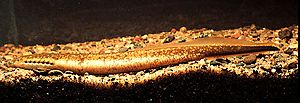Northern brook lamprey facts for kids
The northern brook lamprey (Ichthyomyzon fossor) is a special kind of freshwater fish that lives in rivers and streams. It belongs to the Petromyzontidae family. This lamprey is closely related to the silver lamprey (I. unicuspis). They might even be different forms of the same species!
Quick facts for kids Northern brook lamprey |
|
|---|---|
 |
|
| Conservation status | |
| Scientific classification | |
| Kingdom: | |
| Phylum: | |
| Class: | |
| Order: | |
| Family: |
Petromyzontidae
|
| Genus: |
Ichthyomyzon
|
| Species: |
I. fossor
|
| Binomial name | |
| Ichthyomyzon fossor Reighard and Cummins, 1916
|
|
| Synonyms | |
|
|
Contents
What is a Northern Brook Lamprey?
Northern brook lampreys are unique because they are jawless fishes. This means they don't have jaws like most fish you know. They are considered non-parasitic, so they don't attach to other fish to feed.
Instead of jaws, they have a round, disc-like mouth called an oral-disc. This mouth works like a suction cup. Their teeth are not very developed.
They have a single dorsal fin (the fin on their back) that runs almost their whole body length. This fin connects to their caudal fin (tail fin). Sometimes, the dorsal fin has a small notch.
Their bodies are usually gray-brown on top, with a lighter line down their back. Their belly side is even lighter. Adult northern brook lampreys are usually no longer than 16 centimeters (about 6 inches). They have a long, thin body.
Baby lampreys, called ammocoetes, look a bit like adults. But ammocoetes have a hooded mouth instead of an oral-disc. They also don't have eyes yet.
Where Do They Live?
Northern brook lampreys can be found in many parts of the United States. They live in the Midwest and northeast regions. You can find them in the Mississippi River basin in Wisconsin. They also live in streams that flow into Lake Erie in New York.
They are also found in some parts of Canada.
Their Home and Habitat
Northern brook lampreys live in different places during their lives. When they are young, called ammocoetes, they hide. They burrow under fine sand or plant material in calm waters.
Adult lampreys prefer different spots. They live in sand or gravel in fast-moving waters. They are usually found at the start of streams. These streams are often moderately warm and clean.
What Do Northern Brook Lampreys Eat?
When they are young larvae (ammocoetes), northern brook lampreys are filter feeders. This means they strain tiny bits of food from the water. They mostly eat dead plant and animal matter (detritus). They also eat tiny animals (zooplankton), algae, diatoms, bacteria, and pollen. All these tiny things are found in the fine sand where they hide.
Once they become juveniles and adults, their stomachs don't work anymore. They stop eating completely! Juveniles float downstream for about 4 to 6 months. Adults will spawn (lay eggs) and then die shortly after.
Reproduction and Life Cycle
Northern brook lampreys reproduce around large rocks and cracks. A group of 3 to 7 lampreys will build a nest together. Then, they spawn in groups of 10 to 30.
After the eggs are fertilized, they are often covered. The parents do not care for the young. The adult lampreys die soon after spawning.
Northern brook lampreys start reproducing when they are about 6 years old. This happens when they are fully grown. Spawning begins when the water gets warmer in the spring. Males start building nests. Females lay between 1,200 and 1,524 eggs. They lay so many eggs because many young lampreys do not survive.
Life Stages
The ammocoetes hatch from the eggs about 2 weeks after they are fertilized. They spend the next 5 to 6 years eating algae and bacteria. They live hidden in their burrows during this time.
In the fall, they change into non-feeding juveniles. This change, called metamorphosis, takes 2 to 3 months. After changing, they float downstream for 4 to 6 months. Then, they become sexually mature adults. They take part in spawning and then die shortly after.
Protecting Northern Brook Lampreys
The number of northern brook lampreys is going down. This is happening in the Great Lakes area and the streams that flow into them. One big reason is the use of lampricides. These are chemicals used to kill sea lampreys. Another reason is that their homes (habitats) are being damaged.
A study in Pennsylvania streams found fewer lampreys than expected. The northern brook lamprey was one of the missing species. Scientists think the main problem is the sea lamprey. Sea lampreys are an invasive species in the Great Lakes. They cause problems for other fish.
To control sea lampreys, lampricides are used. But these chemicals also hurt other lamprey species, like the northern brook lamprey. In Minnesota, northern brook lampreys are a "special concern" species. This means their numbers are believed to be declining. This decline is due to lampricide use and damage to their habitats.
The increasing number of sea lampreys means more lampricides are used. This has a negative effect on most lamprey populations, including the northern brook lamprey.


